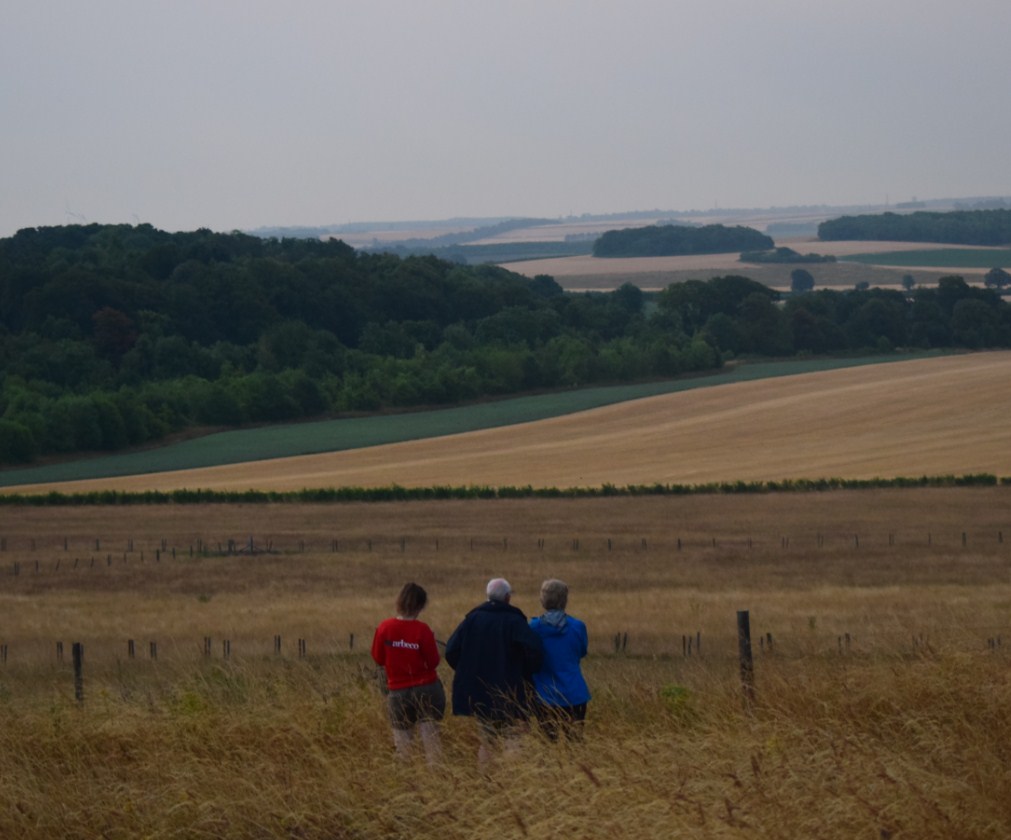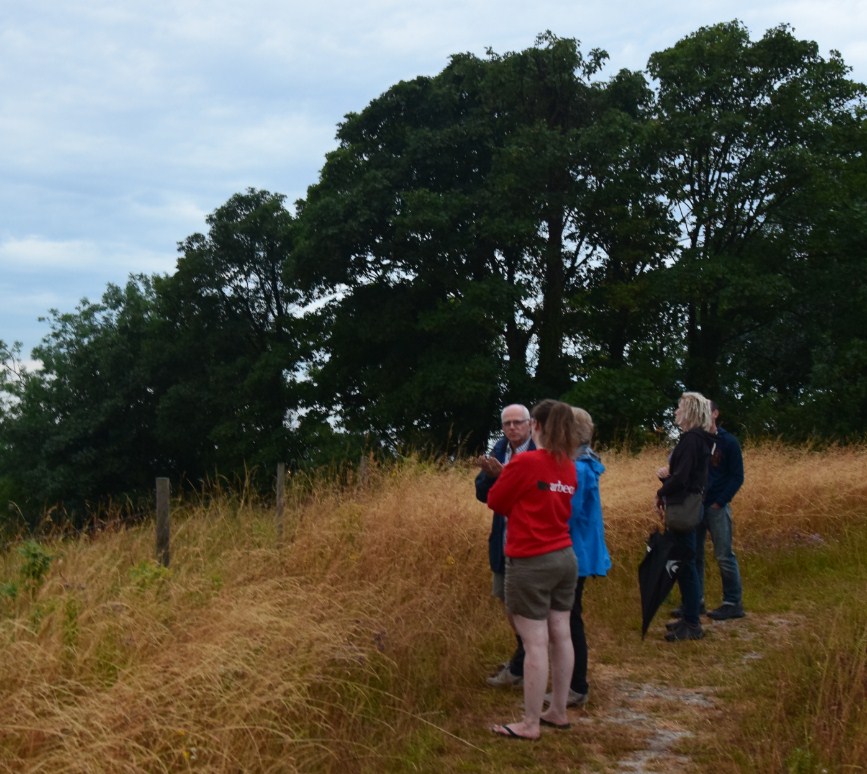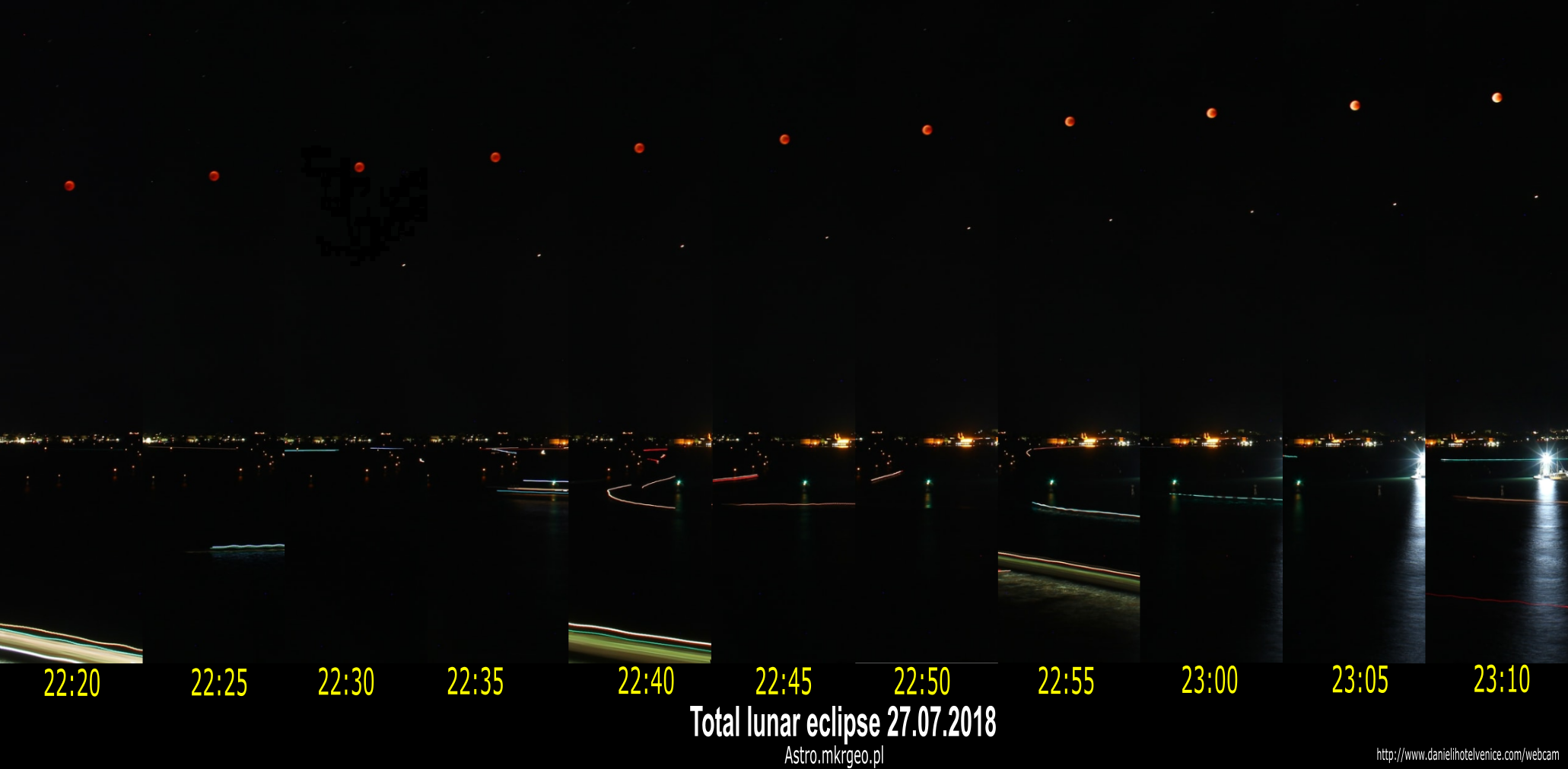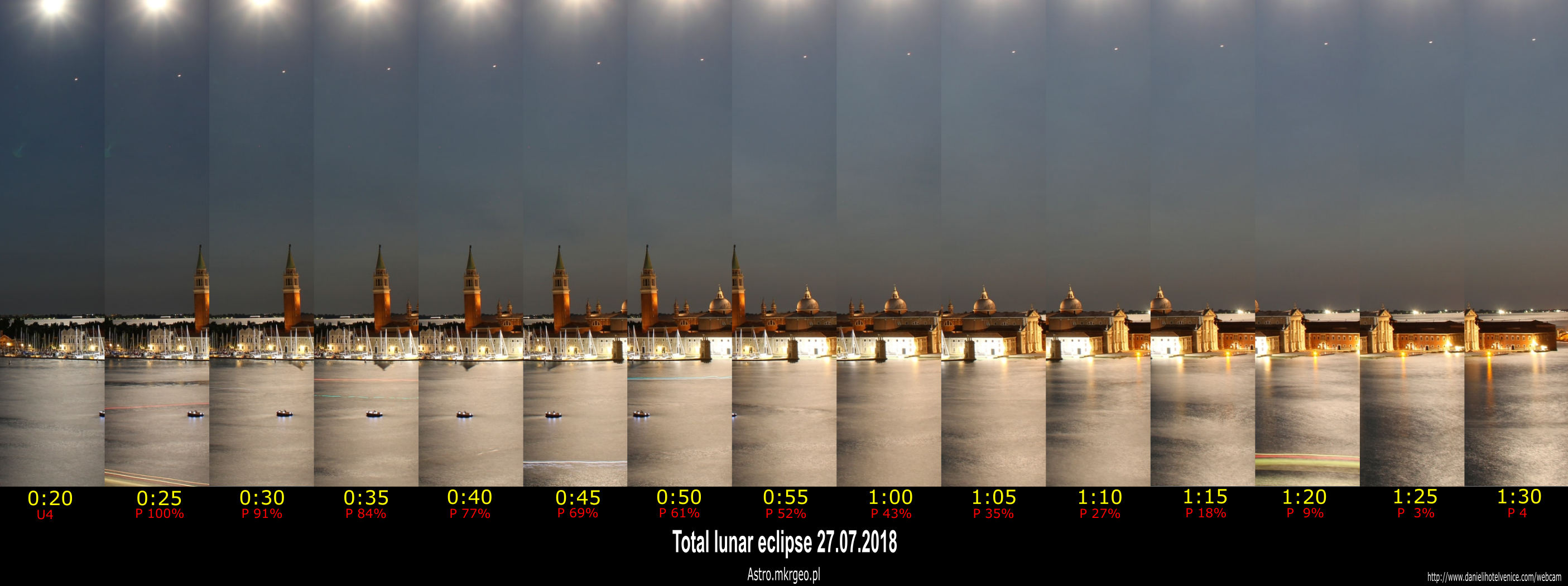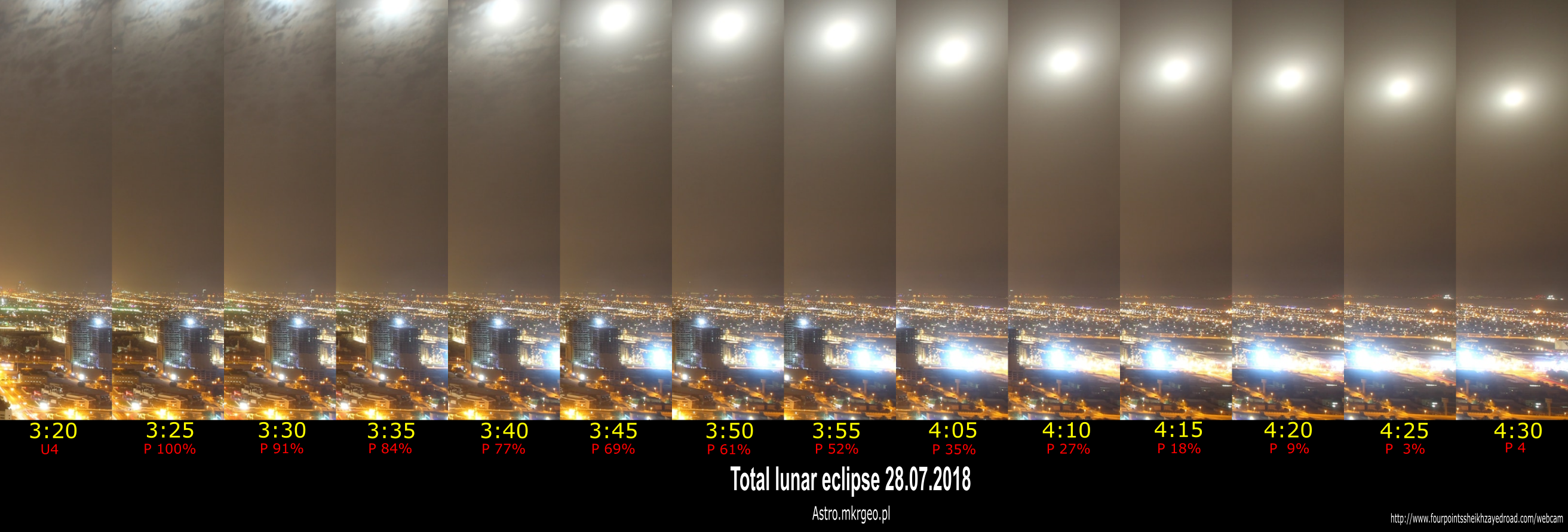Remote observation of the total lunar eclipse
Since I bought the DSLR camera I dreamt about the total lunar eclipse observation. I wanted to repeat my observation scheme on different, much better equipment. Recently I observed the total lunar eclipse in 2015 with a compact camera only. Therefore the total lunar eclipse occurring on Friday evening 27th of July 2018 was a good occasion to see and document this celestial event.
Due to this, I had a few observation goals like watching the totally eclipsed moonrise, light difference documentation from mid-eclipse onwards and observation of the Mars planet being in conjunction with the Moon and approximately in opposition to Earth.
I was looking forward to this perfect and warm Friday evening more because of an extremely long dry spell in east England, which lasted from mid-June. Unfortunately, the weather forecasts for Friday 27th were not favourable. The cold front was predicted, although according to some services, rain appeared to occur around midnight. If so it could give me a perfect occasion to see the eclipsed moonrise and assess the moment when the reddish Moon will become visible in the twilight sky. I was aware of changing the visibility conditions, typical for the front-bearing weather when the sky becomes hazier. In this event, the red Moon could not be visible at the same moment as normal. Anyway, the option to see a red moonrise from the British Isles was a unique occasion, thereby the awaiting was really nervous. I was checking the numerical weather forecast since Wednesday, but they were getting worse as Friday approached. I was hoping that this weather prediction would be delayed and I would experience this unique event eventually.
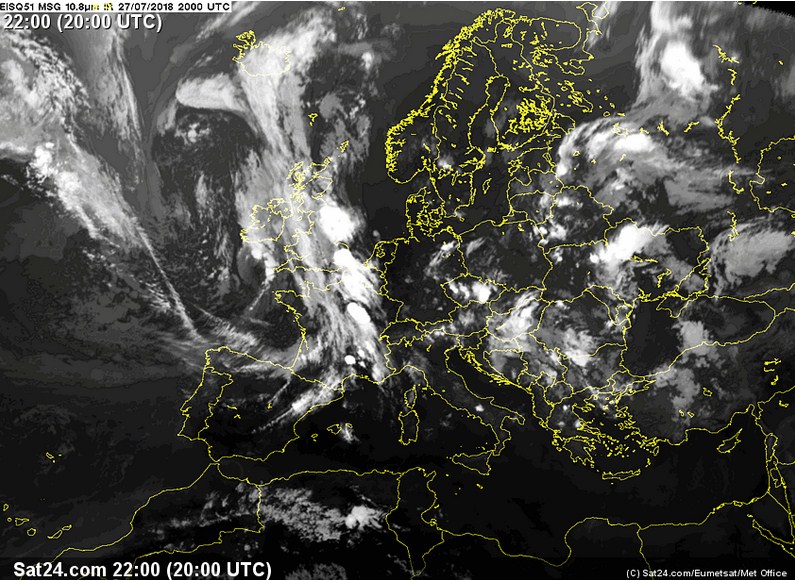
Pic. 1 Cloudiness above Europe at 22:00 UTC+2 on Friday 27th July 2018, infrared image (sat24.com).

Pic. 2 The weather situation above the United Kingdom at 21:45 UTC+1 on Friday 27th July (Weather & Radar app).
Unfortunately, the worst option happened and on Friday 27th around 5 pm started raining. Between the thunderstorms passing above the Cambridgeshire area, I still could see the clear section of the eastern and southeastern sky, which kept me in the hope of seeing at least a bit of a lunar eclipse. I even considered going to the Great Yarmouth coast to try to catch some clear sky. Moonrise there occurred 5 minutes earlier than in Cambridge, according to the forecast rain was about to come around midnight. Finally, I rejected this idea.
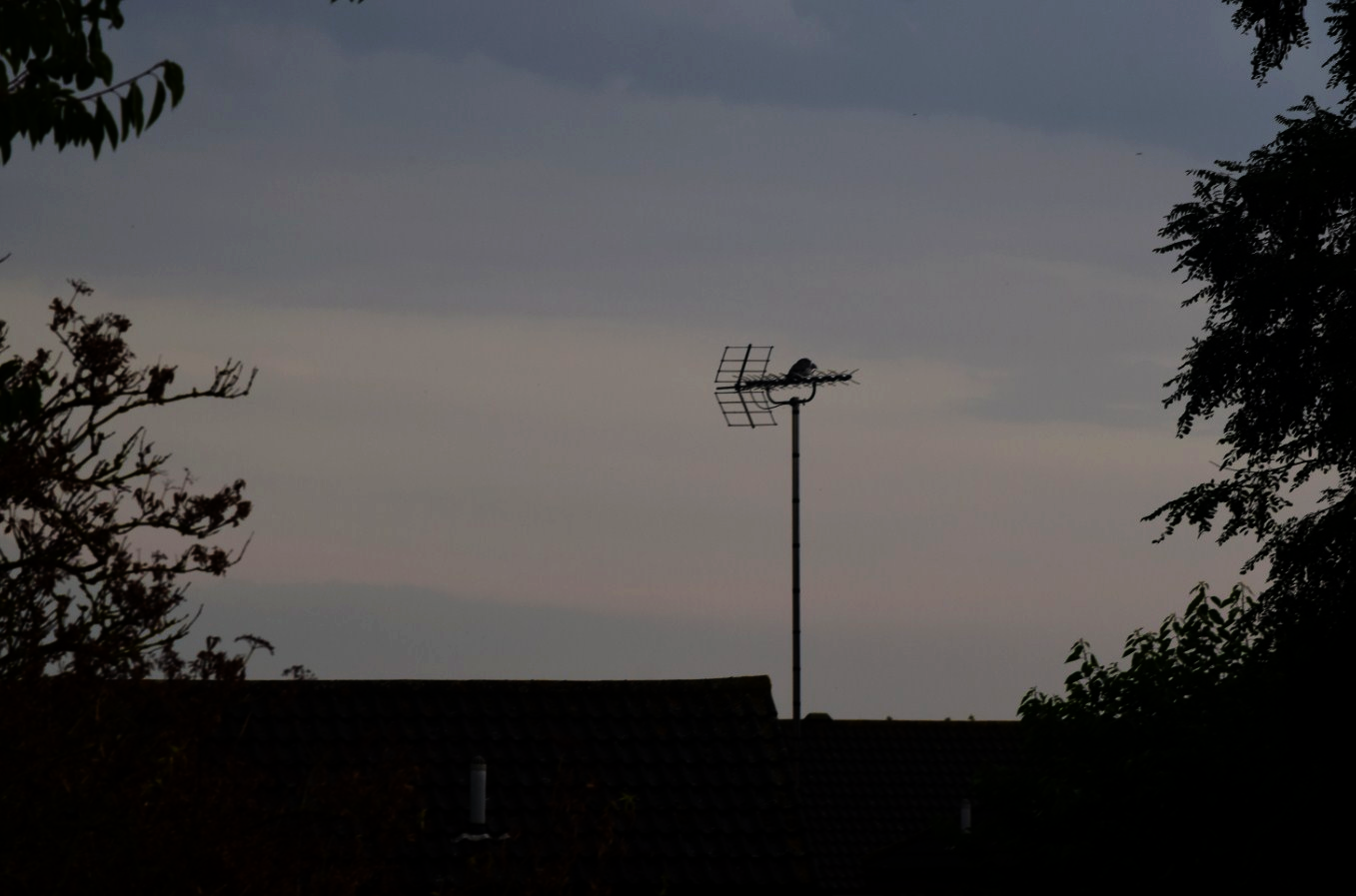
Pic. 3 The elongated clear section of the sky above the eastern horizon, whereas Cambridge, was facing a series of thunderstorms since 5 pm.
After the last thunderstorm, I packed my gear and set on the observation point – Little Trees Hill, from where the southeastern horizon is clearly visible. Being en route I was wondering why I am going there when there is no clear sky on the eastern side. Moreover, huge thunderstorms occurred there. I thought that maybe between these thundery clouds, something even for a while would be visible.
When I came to the hilltop I saw that I was not alone. There were a few people awaiting the same as me for some clear sections of the sky on the southeastern horizon.
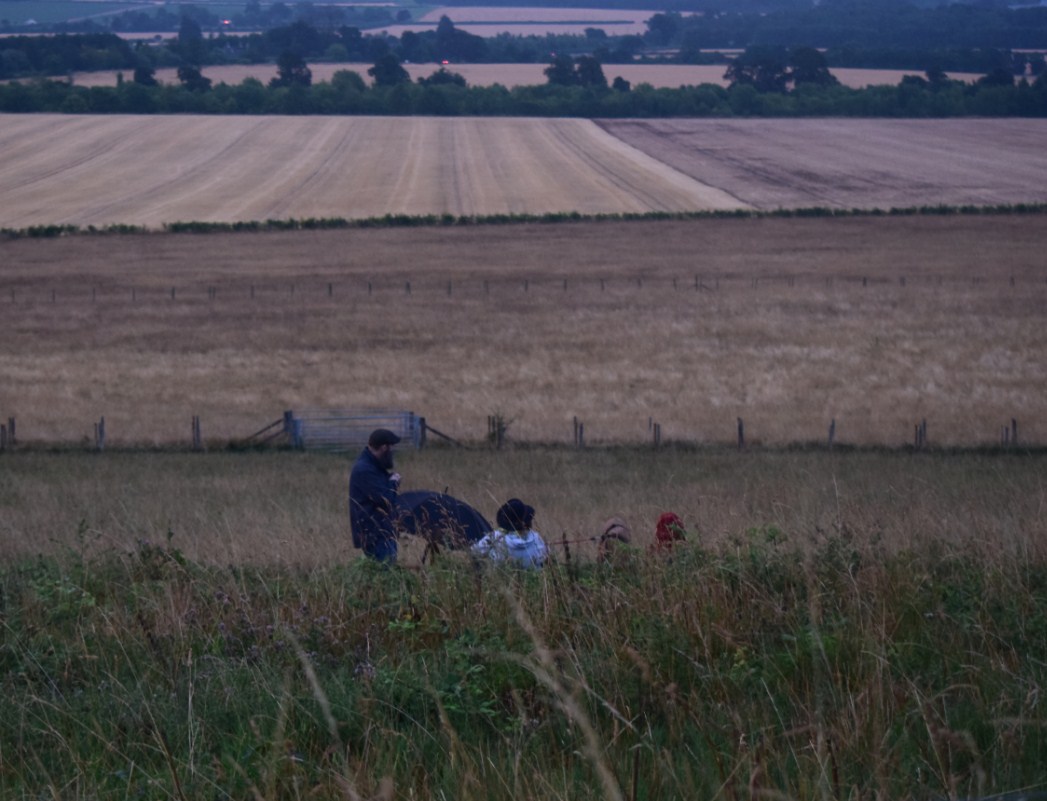
Pic. 4 – 6 People awaiting in hope, that the weather conditions will improve a bit later giving the opportunity to watch the longest lunar eclipse in the XXIst century.
I asked one family and they said to me that they were standing here in the hope of seeing an eclipsed Moon. I said: “The Moonrise should be visible on the azimuth 122deg”. A lady answered: “That’s very precisely”. They have marvelled at my knowledge of this phenomenon. I helped their daughter install the weather app (Pic. 2), thenceforth all of us could see how things stood. It was not looking good because the frontal thunderstorms covered all of the East Anglia regions up to the North Seashore.

Pic. 7 View on the Azimuth 122deg, pointed by timeanddate.com as a moonrise above Cambridge at 20:51 UTC+1. Unfortunately no chance at all.
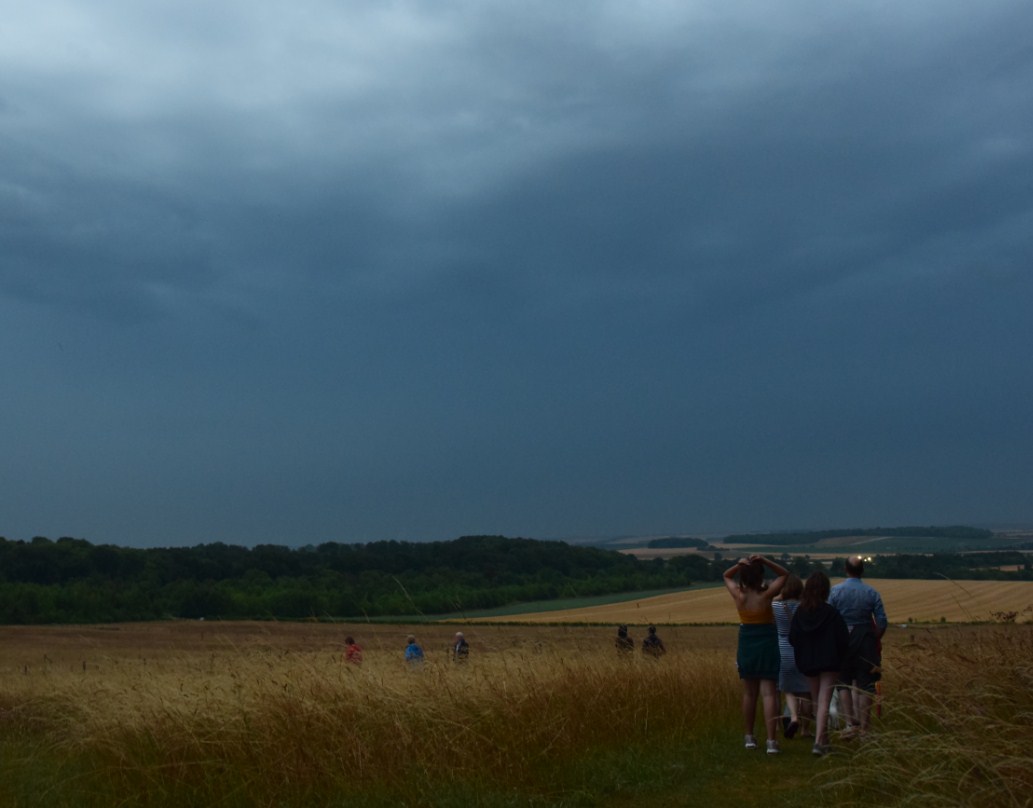
Pic. 8 Thunderstorm passing above East Anglia, seen from Little Trees Hill near Cambridge and frustrated people.
We were looking towards the south, where the sky appeared to be brighter. I could have waited till the weather improved, but after a few minutes, it started to rain again. I decided to back home very disappointed. Other parties stayed there.
Remote observation
After all, I carried out the remote observation of this total lunar eclipse, which was a perfect alternative in this situation. I could see the eclipsed Moon from a few live streams, however, I found also another way to observe this phenomenon.
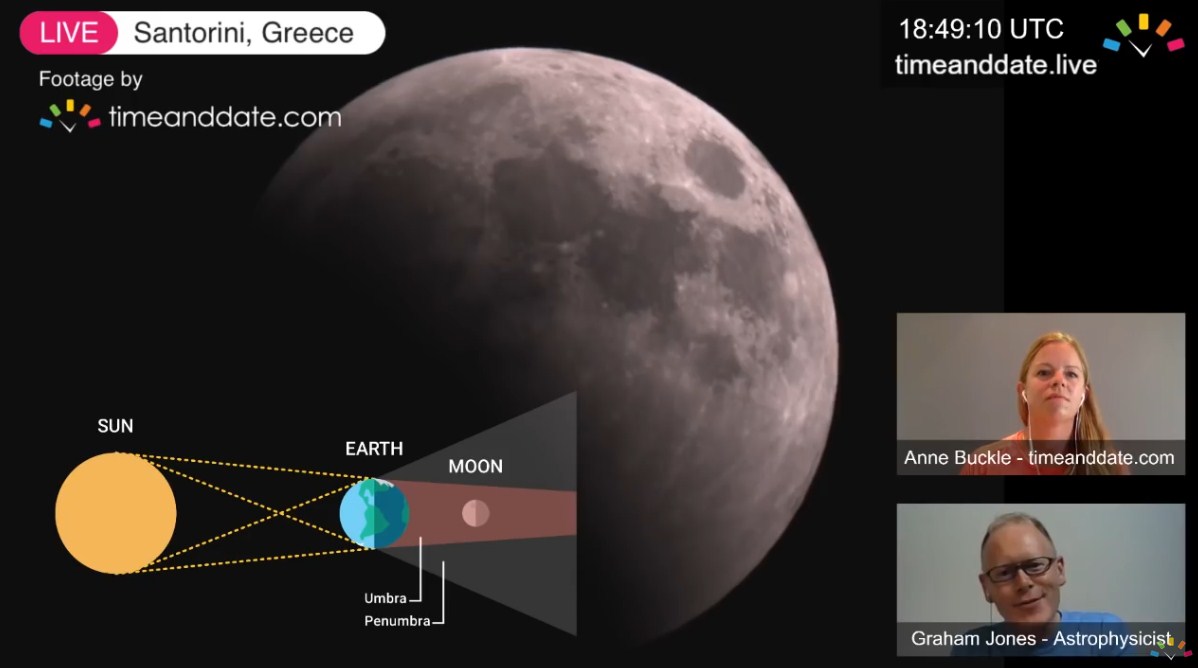
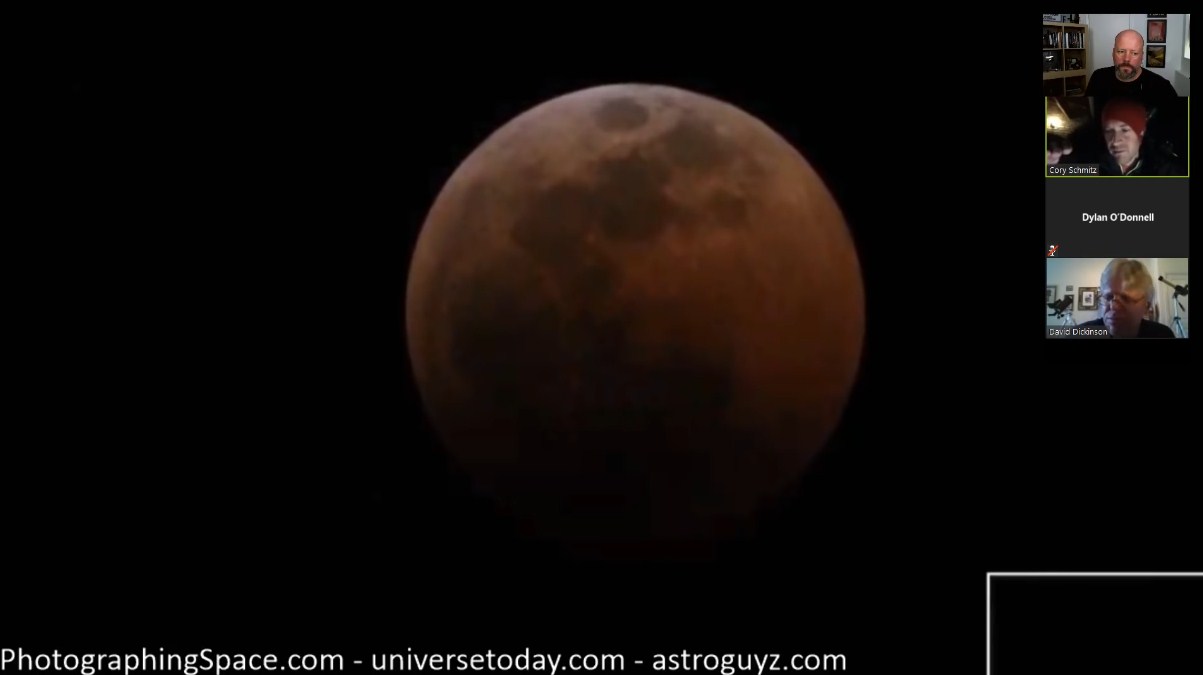
Pic. 9, 10 An example of the total lunar eclipse live stream. You can see an eclipsed Moon from a few perspectives around the Globe, however, the lunar disk itself will not be free of gadgets, links, etc. otherwise the Moon will look smaller. 9 – Timeanddate.com, 10 – PhotographingSpace.com. There were another few streams to choose from.
I used high-quality live web cameras located in a few places in Europe and one in Dubai. These cameras including archive images up to 1 month before helped me to collect the data from the time when I was out of my laptop. These 5-minute intervals combined with high ISO sensitivity brought amazing results for me. Because I have gathered the data from different parts of the continent I had various sky conditions.
There were also different factors, that played a leading role in this observation. I have put all of them below:
- Various night-time moments: For almost all web cameras (except the Dubai one) the observation period spread from around 9 pm to max. 1.30 am. The observation commencement and termination mainly depended on the first presence of the Moon in the webcam. In other cases (Nice, Stockholm) I was trying to see eclipsed moonrise as early as possible after sunset.
- Local weather conditions: were usually pretty good in these observation points, they were not totally free of clouds. Clouds were prevailing mainly near the south-eastern horizon and some patchy mid-level clouds were also present.
- The camera direction: the most important factor, which decided the viability of the observation. Usually, Moon watching was conducted when Moon was seen in the camera.
- Terrain features: The best were places located onshore. The sea surface reflects moonlight perfectly. I was able to see the eclipse progress then.
- Artificial light distribution: interrupted the observation especially when the street lamp or another source of illumination was on the same azimuth with eclipsed Moon.
Now I would like to present the local circumstances in the places, where the total lunar eclipse was observed:
- Kraków – Observation was carried out since the eclipsed Moon rose above the Wawel Castle just after 9 p.m. and left the camera view at 0.35 a.m. The sky was clear, making the Moon intact by clouds. Despite the high level of light pollution, the illumination increased after the total eclipse was noticed. The observation through this camera was extended 15 min (3 shots) more due to increasing lunar glow.

Pic. 11 Total lunar eclipses in Kraków seen through the Sheraton Grand Hotel webcam. Click to enlarge.
- Stockholm – A perfect web camera bearing on the south-west direction combined with a much slower twilight progression could give a fantastic opportunity to chase the fully eclipsed Moon as early as possible after sunset. This kind of observation has failed eventually due to patchy stratocumulus clouds covering the horizon sky. The observation started at 9.15 pm at the moment of moonrise. Moon became visible just after U3 contact, unfortunately. In general, the weather conditions in Stockholm were the increasing illumination was less noticeable due to twilight conditions. Stockholm in late July still experiences a white night with min. Sun altitude is around 10 deg below the horizon. It makes the sky brighter finally.

Pic. 12 The total lunar eclipse seen in Stockholm through the Sheraton Stockholm hotel webcam. Click to enlarge.
- Florence – The webcam features a terrific view of the city centre with Tuscan-Emilian Apennines and the eastern sky in the background. Also in the case of this streaming near the horizon sky was overcast and clouds gave way to the eclipsed Moon at least 20 min after a rise. Moreover, the Moon was visible shortly because after the next 5 shots left the streaming frame. Anyway, it covered the U2 contact.
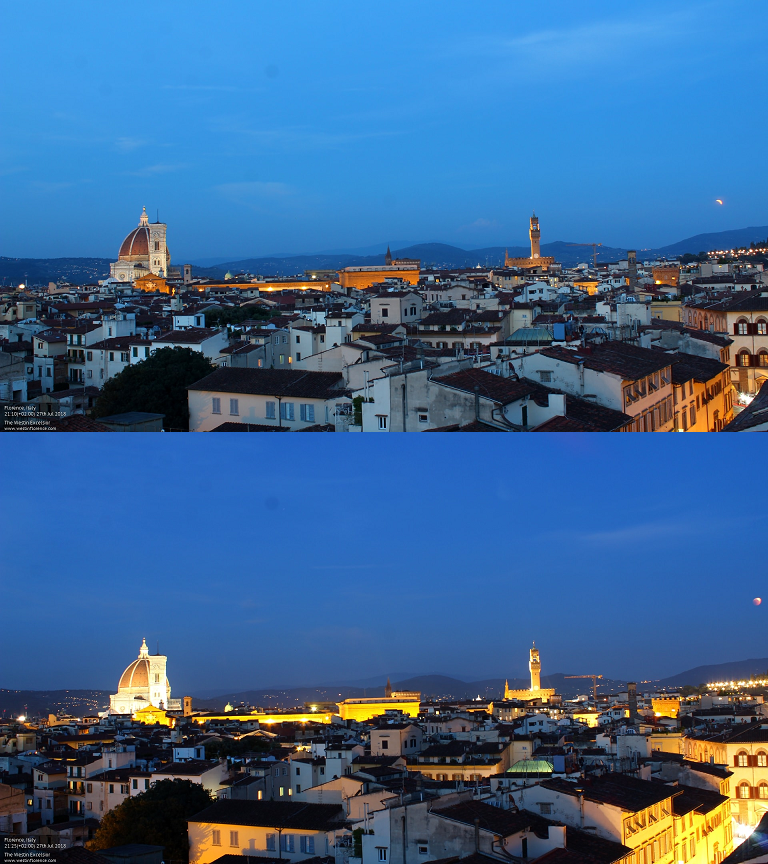
Pic. 13 Total lunar eclipses seen in Florence through the Westin Excelsior webcam. Click to enlarge.
- Venice – Thanks to this webcam born in the SSE direction I could see the nearly whole eclipse. A partially eclipsed Moon became visible during dusk. As twilight and eclipse progressed the Moon was turning into a reddish tint. During the total phase, the Moon hid behind altocumulus clouds for around 10 min. Next, the entire time was clearly visible until the camera frame. Because of the vicinity to the camera frame and the big lunar glow still appearing in the camera, the observation was carried out till P4 contact. The data from this webcam brought the best output of this remote observation. Read below the details of this observation.

Pic. 14 Total lunar eclipses seen in Venice through the Hotel Danieli webcam. Click to enlarge.
- Monte Carlo – The webcam has been headed more on the ground than on the sky. As a result, the sky takes maybe a quarter camera frame. Moreover, the camera is headed south, therefore I couldn’t see the Moon at all. Because this webcam covers the seaside I could see increasing lunar light reflected on the water’s surface. Regrettably, the sky was not fully clear and the Moon was overcast from time to time giving a worthless output of the observation.

Pic. 15 The light reflection during the total lunar eclipse seen on the Monte Carlo coast through the Le Meridien Beach Plaza hotel webcam. Click to enlarge.
- Nice – nice view on the French Riviera coast with a rising partially eclipsed Moon after 9 pm. Due to high light pollution in the webcam frame, the Moon presents very faintly, especially around mid-eclipse. Moreover, the lunar disk was veiled by high-altitude clouds from time to time. The red Moon was present in the camera frame almost for the entire totality.

Pic. 16 The total lunar eclipse seen on the French Riviera in Nice through the Le Meridien hotel webcam. Click to enlarge.
- Dubai – The observation output was surprisingly good. In this case, patchy altocumulus clouds helped me to spot the illumination changes when started to reflect the moonlight. The most intriguing fact is that it started getting brighter around 10 min before the end of the totality. Despite the absence of the lunar disk in the webcam frame, the increasing light reflected by clouds was noticeable. As time flew the Moon gradually entered the webcam frame giving the light glow several shots before. The view from Dubai was the most light-polluted, although the data was sufficient enough to conduct a pretty good observation. In later time, when the Moon went a bit down on the sky the moonlight started to diminish due to a big concentration of dust.
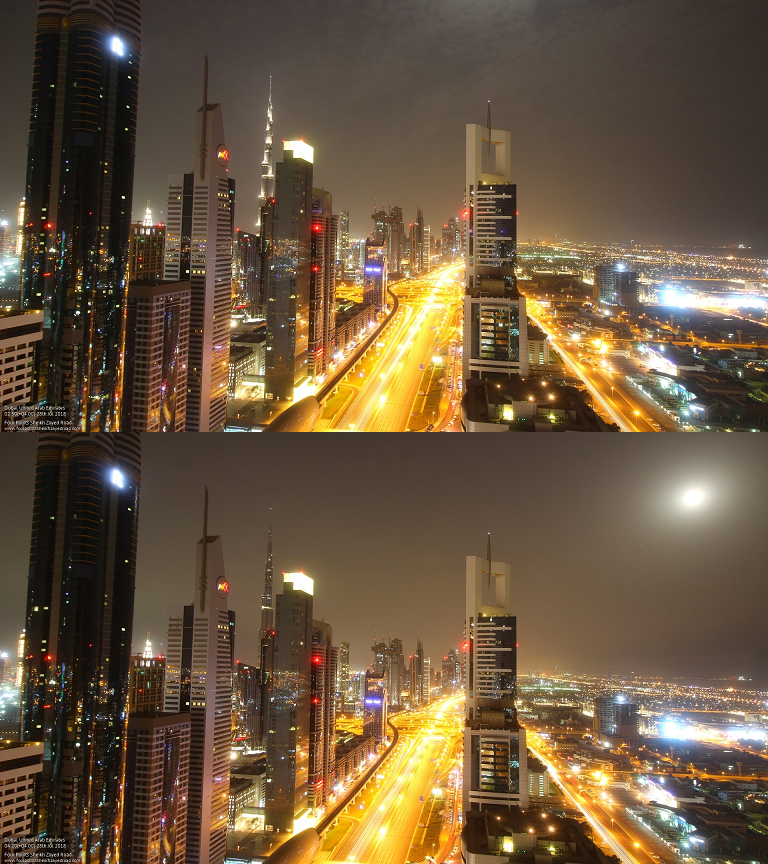
Pic. 17 Total lunar eclipses above Dubai, see the illumination changes in the dusty atmosphere through the Four Points Sheikh Zayed Rd hotel webcam. See the original image here.
- Bryne – This is a different kind of webcam, that doesn’t work perfectly in night-time conditions. The pros of this webcam are quite a big zoom, which makes the landscape very detailed. The webcam refreshes mainly every 10 – 15 minutes, sometimes less frequently. The Moon was better visible through this webcam. Because the data comes from the twilight time I could asses, from what moment the red Moon was visible. In the shot from 22:45 UTC+2, the Moon is almost invisible due to early civil twilight. The lunar disk is clearly visible in the next shot at 23:00 UTC.
The main observation of the total lunar eclipse comes from two webcams: Venice and Dubai. In both cases, I focused on illumination level changes. The period of observation has been divided into 3 sections: totality, partiality and penumbral. The illumination during totality has been recorded in Venice. Next, the picture was modified with Photoshop Express, where was found that since mid-eclipse to U3 contact the illumination grew marginally, especially before the end of totality, which is clearly understandable.
The Moon itself presented poorly in the webcam view, although the umbra movement across the lunar disk was noticeable. In extreme moments of the totality, the lunar disk appeared to look brighter, especially on the side closer to umbral contact. The upper edge of the lunar disk remained the brightest throughout the entire totality because the Moon was not dipped in Earth’s umbra enough.
In order to enhance the colours and roughly point out the moments of the illumination change, I have modified these photos in the Adobe Photoshop package.

Pic. 19, 20 Total lunar eclipses seen from Venice: 19 – original sequence, 20 – modified in Adobe Lightroom CC. Click to enlarge.
The partial phase seems to be the most interesting period of observation from the webcam point of view. The illumination change is the most noticeable at this time. The lunar disk turns from red (with visible dark spots – seas) to a shiny big point. When lunar obscuration was around 75% the reflected moonlight started to be seen on the seawater surface.

Pic. 21, 22 Total lunar eclipses seen in Venice, the partial phase: 21 – original sequence, 22 – modified in Adobe Lightroom CC. Click to enlarge.
The penumbral phase marked a significant brightness growth just after the U4 contact. The illumination difference fainted as the penumbral phase progressed bringing the full Moon conditions around 30 mins before the end of the eclipse. It has been verified clearly on the modified image.
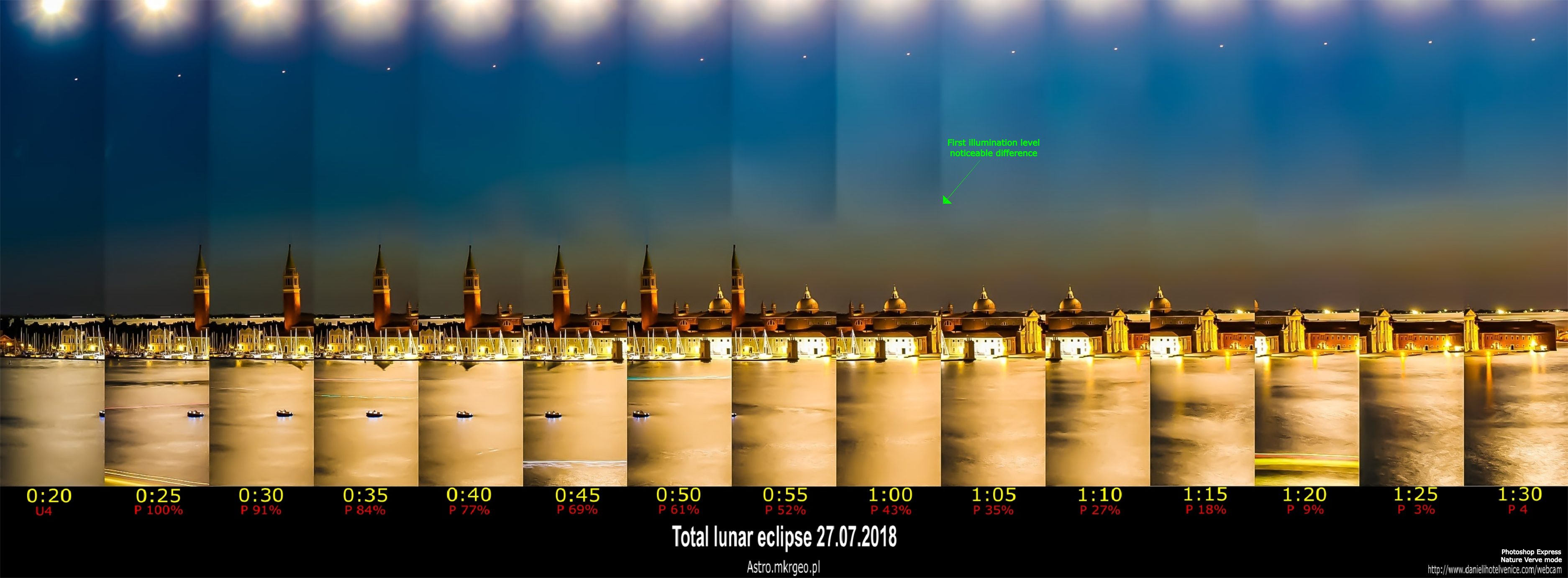
Pic. 23, 24 Total lunar eclipses seen in Venice, penumbral phase. 23 – original sequence, 24 – modified in Adobe Photoshop Express with a rough moment where illumination changes terminated. Click to enlarge.
Dubai webcam has been located in different conditions. There is high light pollution and not the sea in the frame. Despite these factors, the output was surprisingly good. I could spot increasing illumination, especially on the altocumulus clouds just after the U3 contact. Interestingly is also the fact, the sequence captured at the U3 moment looks slightly brighter than previous ones. The modified photo clarifies this issue, which could be used by the change of local atmospheric conditions (some dusty air movements or increasing cloudiness, that reflected the light glow). Therefore the sequence from 2:05 am and 2.10 a.m. looks more yellowish. In the shot from 2.15, a faint whitish moonlight becomes visible.

Pic. 25, 26 Total lunar eclipses seen in Dubai. End of totality and entire partial phase with a lunar disk out of the camera frame, however, the luminance changes have been noticed. 25 – original photo sequence, 26 – modified in Adobe Photoshop Express. Click to enlarge.
The penumbral phase in the Dubai webcam was not clearly visible. Firstly the Moon was not visible entirely in the frame, hence the brightening of the top of the sequences was caused by the approaching of the lunar disk towards the camera. Secondly, as the Moon moved lower in the sky, moonlight became fainter due to extremely dusty conditions. In the outcome, the lunar disk during P4 contact was quite fuzzy and not as bright as appeared to be at that time.
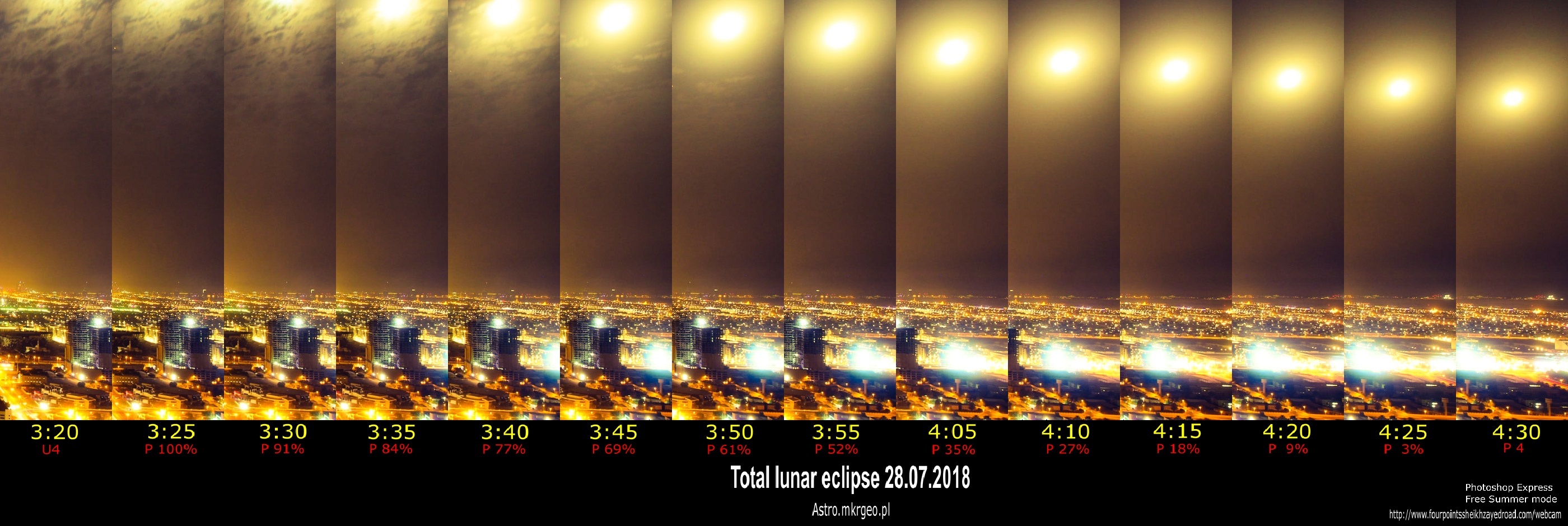
Pic. 27, 28 Total lunar eclipses seen in Dubai, penumbral phase with Moon diminishing in the dusty atmosphere: 27 – original photo sequence, 28 – modified in Adobe Photoshop Express. Click to enlarge.
Conclusions
- The view through the webcams (except the last one in Bryne) can be compared to the ability of human vision in field conditions.
- Despite brightening the lunar disk during totality the light level of the observation area remained the same. It needs to be repeated with a DSLR camera.
- The first noticeable increase in the light level has been observed in the partial phase when umbral obscuration is around 75%.
- The biggest difference in illumination level has been observed when umbral obscuration is lower than 60%.
- The points 2nd, 3rd and 4th can be related to the chart as per below.
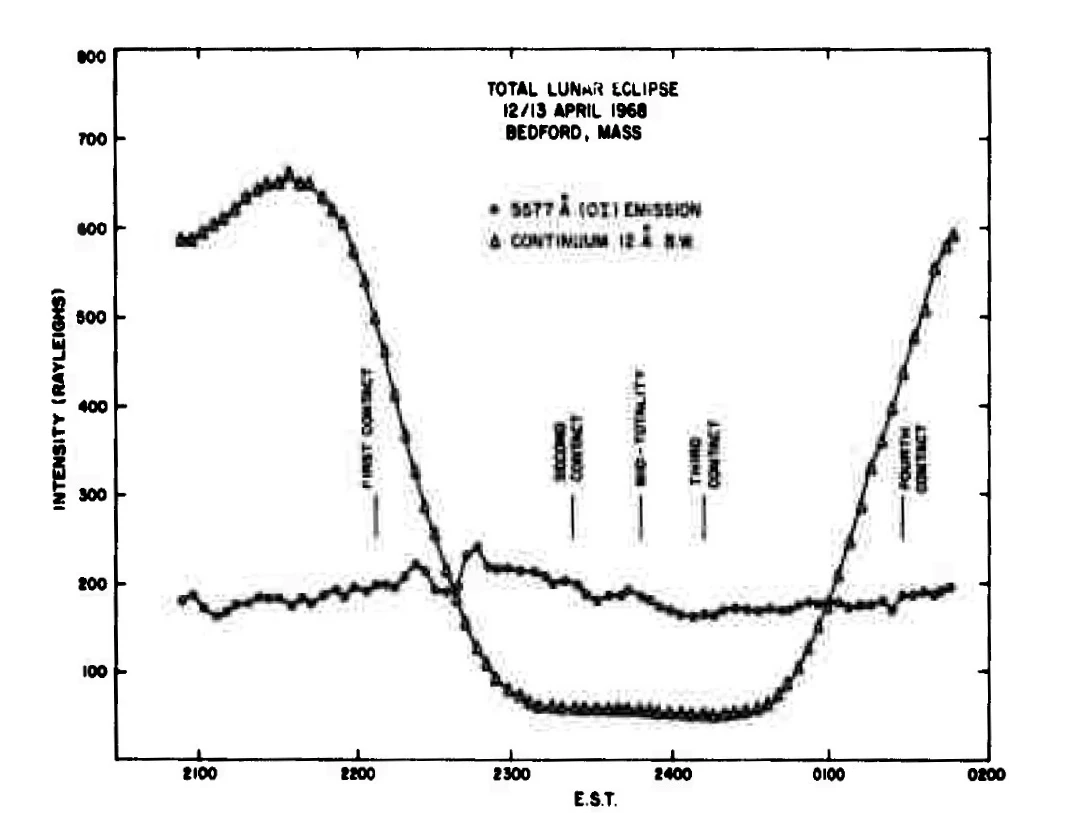
Pic. 29 The illumination changes chart according to S.M. Silverman, based on total lunar eclipse observation during the 12th/13th April 1968 night.
- The biggest difference in illumination level has been observed up to around 85% penumbral obscuration.
- When umbral obscuration was lower than 40 % the illumination changes were not noticeable.
- The lunar light corona became visible just after U3 contact.
- In extremely hazy conditions the illumination conditions remain stable throughout the entire penumbral phase
So, the observation has been done. In the meantime in Cambridge…

Pic. 30 Partially eclipsed Moon is just behind the receding clouds.
In the finish, I can say, that the remote observation of a lunar eclipse is a perfect choice for someone, who lives in a different part of the Globe, where the eclipse is invisible or when the weather is not good enough.
Mariusz Krukar
References:
- Silvermann S.M., 1974, Sky brightness during eclipses, Air Force Cambridge Research Laboratories, Massachusets.
Links:
- Remote observation of the longest lunar eclipse in the XXI century – details
- https://www.deckchair.com/
- https://www.roundshot.com
- https://www.panomax.com
Youtube:
Read also:
- African “Ring of fire on the live stream and web cameras
- Remote observation of the partial solar eclipse

